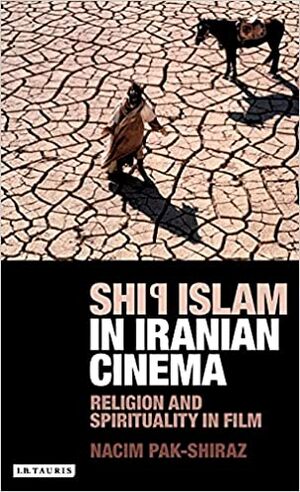Shi'i Islam in Iranian Cinema: Religion and Spirituality in Film
The book Shi'i Islam in Iranian Cinema: Religion and Spirituality intends to provide a cultural and socio-historical background to some of the different modalities of Shi’ism.
 | |
| Author | Nacim Pak Shiraz |
|---|---|
| Language | English |
| Genre | cultural and socio-historica |
| Published | 2011 |
| Publisher | I.B. Tauris |
| Pages | 256 |
About the authorEdit
Nacim Pak-Shiraz is Lecturer in Film and Persian studies at the University of Edinburgh. She completed her PhD at the School of Oriental and African Studies (SOAS), University of London. She is also the author of several articles concerning the role of film in Iranian culture and politics.
About the bookEdit
This book published in I.B. Tauris; 1st edition (September 23, 2011), has 256 pages and best sellers rank of 9,842,071 in Books.
This work aims to situate film as a valid and important tool in the understanding of many of the current debates within Iran, rooted as they are in much older historical and traditional discourses on religion, power and politics.
Abstract of chaptersEdit
Chapter 1, Shi’ism in Iran: An Historical OverviewEdit
This chapter surveys the formation and development of Shi’ism and its manifestations in Iran and explores the more formal and institutional facets of Shi’ism and its development in Iran although these aspects were not and have not always been in line with the actual practices of the laity.
Chapter 2, Contemporary Iranian Discourses on Religion and Spirituality in CinemaEdit
This chapter goes on to compare and contrast the various debates both within and outside Iran. These include an analysis of the religious discourses on the permissibility of cinema itself, the debates around the compatibility of the medium with religion and spirituality as well as the launch of the ‘spiritual cinema’ (sinama-ye ma‘nagara) category in Iran in 2005 and the various attempts by film-makers, journalists, academics and the authorities to define it adequately.
Chapter 3, Filmic Discourses on the Role of the Clergy in IranEdit
This chapter explores the formalistic approach to religion, represented by the ulama and their centers of learning. the diversity of their views is a source of some of the most dynamic and profound debates on the role of the clergy in the long history of this institution in Iran. The films that the author studies here articulate a discourse that is a significant departure from previous representations of the clergy in Iran.
Chapter 4, Sight, Sound and Sufism: Mystical Islam in Majidi’s FilmsEdit
This chapter studies the highly personal and Sufi approach to religion. The author here examines how filmmakers employ film to discuss mystical concepts in a more personal approach to religion. She analyses Majid Majidi’s films, that are depictions of man’s struggle to spiritual attainment, a discourse that stems from Sufism, a mystical dimension of Islam.
Chapter 5, Cinema as a Reservoir for Cultural MemoryEdit
This chapter explores how cinema has provided a new medium of expression for one of the most popular discourses within Shi’ism. The author studies how cinema gives new life to a Shi’i expression that is communal and public, but unpopular with the formalistic approach propounded by the religious authorities and examines film’s engagement with one of the oldest Shi’i narratives, the death of the third Shi’i imam, Husayn, through ta’ziyeh (the only Islamic drama). Being a popular discourse within Shi’ism, ta’ziyeh does not always draw its language or facts from the official discourses on Husayn. Rather, these expressions of the laity have provided a means for personal and direct engagement with the figure of the Imam. They have also led to the creation of religious rituals, many of which have disapproved by the clergy and been condemned by them as unIslamic.
Chapter 6, Thinking Films: Kiarostami, A Poetic PhilosopherEdit
Finally, in chapter 6 the author examines the philosophical approach to religion. She means the approach that reflects upon the various religious discourses, be they formalistic, mystical or even scientific. She also examines the films of Abbas Kiarostami (philosophical films that, among other things, deliberate upon the question of religion) within a philosophical framework and demonstrates how they may be read as ‘poetic philosophies’ that both resonate with modern Western philosophy and simultaneously emphasize the lyrical language of Iranian poets.